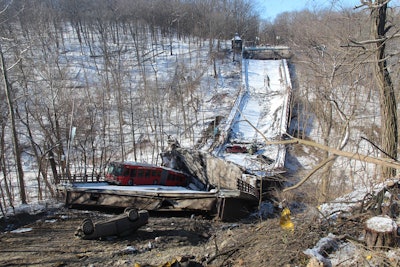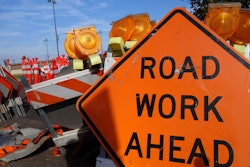
Newly released video images from a transit bus provide further glimpses into the cause of a bridge collapse in Pittsburgh in January.
Two screen shots from the bus’ video before the bridge fell 100 feet to the ground were released May 5 as part of an update from the National Transportation Safety Board’s investigation into the collapse of the Fern Hollow Bridge. The bus and five other vehicles fell to the ground when the 447-foot-long, snow-covered span collapsed at 6:40 a.m. January 28.
Two vehicle occupants were seriously injured, and two had minor injuries, the NTSB reports. Four other occupants were not injured, and the injury status of another is unknown.
The transit bus’ front video camera shows the spot where the bridge deck separated from the east expansion joint, and its side camera has a shot at around the same time showing that the west end of the bridge had already fallen off its abutment, NTSB says in the update to its preliminary report.
NTSB adds that it “has not found any evidence of widespread deficiencies with rigid K-frame superstructure types.”
 Video frame from the bus' forward-facing camera, showing the opening expansion joint.National Transportation Safety Board
Video frame from the bus' forward-facing camera, showing the opening expansion joint.National Transportation Safety Board
 Video frame from the rear-facing curbside camera, showing the west end of the bridge already fallen off the west abutment.National Transportation Safety Board
Video frame from the rear-facing curbside camera, showing the west end of the bridge already fallen off the west abutment.National Transportation Safety Board
The 50-year-old bridge had been rated as being in poor condition since 2011. It carried Forbes Avenue over Frick Park. It had a weight limit of 26 tons and was traveled by about 14,000 vehicles a day.
In a previous premilinary report February 7, NTSB described the bridge as “an uncoated weathering steel, three-span, continuous rigid ‘K’ frame structure with two welded steel girders, welded steel floor beams, and rolled steel stringers.”
NTSB said then that no primary fractures were found on "fracture critical" areas on the welded steel girders. Fracture critical areas are those that could cause the bridge to collapse if they failed.
It said the collapse occurred due to a structural failure on the bridge’s west end, but it has not yet determined the cause.
The 2013 New Flyer transit bus was traveling east when the bridge collapsed. The last vehicle to reach the bridge drove off the east abutment and landed on its roof on the ground below.
At the bridge’s demolition after the crash, NTSB investigators examined the structural elements using 3D laser scanning technology and sent them to the Federal Highway Administration’s Turner-Fairbank Highway Research Center in McLean, Virginia, for future testing, or to NTSB’s Materials Laboratory for analysis.
“NTSB and Federal Highway Administration investigators plan to conduct both mechanical and chemical testing on material samples prepared from portions of each bridge leg, as well as several girder sections,” NTSB’s update says. “Investigators also plan to examine the plate dimensions and weld quality. All aspects of the collapse remain under investigation while the NTSB determines the probable cause, with the intent of issuing safety recommendations to prevent similar events.”
Meanwhile, the Pennsylvania Department of Transportation is planning a $25.3 million replacement bridge, which will be covered by federal funds under the new $1.2 trillion infrastructure law. Swank Construction, based in Pennsylvania, and HDR have been hired to design the new bridge. After it is built, the city of Pittsburgh would retain ownership of the span.
PennDOT said in March that the new bridge’s design would contain three spans consisting of “continuous composite prestressed concrete I-beam.” It will follow the same route as the former Fern Hollow Bridge.
Below are some preliminary renderings of the future bridge that would have four 10-foot-wide lanes with a sidewalk on one side and a bike and walking path on the other:
 PennDOT
PennDOT
 PennDOT
PennDOT
 PennDOT
PennDOT
 PennDOT
PennDOT
 PennDOT
PennDOT










